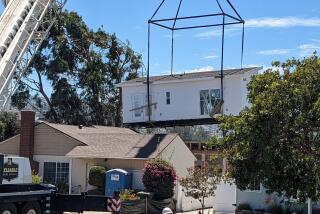Serene Patch of History Will Be : Home to Needy Tenants of Today : Housing: The 16 bungalows in St. Andrew’s Court are among 600 renovated and new units that the Community Redevelopment Agency plans on providing within five years.
HOLLYWOOD — The vacant and boarded up St. Andrew’s Court is the type of Southern California housing they don’t make anymore: a tan horseshoe of 16 gabled bungalows that face a narrow courtyard shaded by brawny old ficus and Victorian box trees. Birds dart in and out of the overgrowth, and a concrete fountain rests in the center.
Built in 1919, St. Andrew’s Court radiates an incongruous serenity in a neighborhood where signs warn against those stopping to buy drugs.
Soon St. Andrew’s Court, on North St. Andrew’s Place near the intersection of Sunset Boulevard and Western Avenue, will again have residents to enjoy its peaceful charms.
Along with a handful of new and renovated housing complexes scattered throughout Hollywood, the historic cottages are included in the Community Redevelopment Agency’s five-year plan to provide the area with up to 600 low- and moderate-income housing units.
Last week, as part of the overall 1,100-acre Hollywood Redevelopment Project, redevelopment officials adopted a Hollywood Housing Strategy that when implemented could furnish low-cost housing for 2,000 individuals and increase emergency shelter space in the area by 100 beds.
Though most of the housing has been supplied by construction, a significant portion, perhaps as much as one-third, is being provided by the purchase and renovation of several of the area’s dilapidated structures.
Some of the apartment complexes, says Leslie Lambert, the redevelopment agency’s housing manager for policy and development, can be bought for between $20,000 and $40,000, per unit, and as a result, cost much less than building housing units, even when renovation costs are considered.
“Given the condition of the real estate market in Los Angeles, it’s cheaper for us to look at buying existing apartments,” said Lambert, who estimates the cost of a new building can be as high as $150,000 per unit, partly because new apartments have to be larger because of Hollywood’s changing residential mix.
In the last decade, more, and bigger, families have moved into the area, Lambert said, and as a result, some of the apartments now under construction have up to four bedrooms.
The Hollywood Redevelopment Project, adopted by the City Council seven years ago, targets an area bounded by La Brea Avenue on the west, Western Avenue on the east, Franklin Avenue on the north, and, on the south, Fountain Avenue at the border with West Hollywood, and Santa Monica Boulevard along the rest of the section.
About $360 million of the project’s estimated budget of $922 million will go toward providing low- and moderate-income housing, says Len Betz, the project manager. The housing will be made available to families of four with maximum annual incomes of $23,450, couples with a maximum income of $18,750, and individuals with an income no higher than $16,400. Of the 600 projected units, 472 are already being built or renovated.
CRA officials see the housing strategy as a way to alleviate a serious overcrowding problem in Hollywood, an area in which 90% of the residents are renters and where nearly three-quarters of the households can be categorized as low-income.
According to recent census data, the number of Hollywood households with three or more people increased 17% in the 1980s, while the number of rooms per housing unit declined more than 15% during the same period.
Another preliminary report done for the project in 1985 concluded that 65% of the 14,000 housing units in the redevelopment area needed repairs or improvements.
More to Read
Sign up for Essential California
The most important California stories and recommendations in your inbox every morning.
You may occasionally receive promotional content from the Los Angeles Times.






